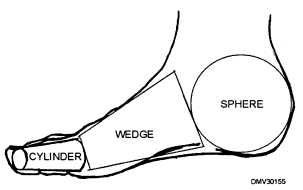CombiningForms
Introduction
Regardless of how complicated objects seem, you can reduce them to a
combination of the four basic forms. Train yourself to see all objects in their
basic forms. Practice combining basic forms to create complex objects.
Combining
forms
Basic forms combine to create complex objects. For example, a close look at
a foot reveals a series of cylinders (toes), a wedge or modified cube
(forefoot), and a sphere (heel). By drawing basic forms proportionally, you
can draw a human foot.
Figure 3-18 shows a foot reduced to basic forms.
Figure 3-18.—A human foot reduced to basic
forms.
Thumbnails
Before drawing, imagine the best descriptive view for your illustration.
Draw several small sketches or thumbnails to determine the best view. Draw
general shapes or masses without details. Establish correct proportions for
larger objects first, then proportion smaller objects. When you have a very
rough outline of the best possible view, you are ready to enlarge the sketch
and begin drawing.
Enlarging the
Once you select the best view of the object, transfer the mass and proportions
sketch
to paper for the finished drawing. Indicate areas of mass without detail.
Make sure proportions are correct. Keep the drawing clean and free of
unnecessary lines.
Continued on next page
3-16


